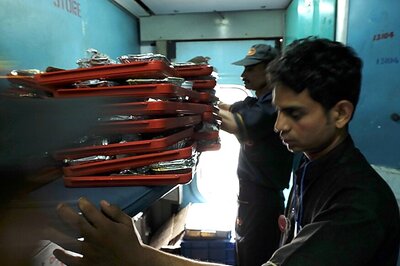
views
The health chapter in the BJP’s election manifesto is titled “Health for All” and the Congress manifesto’s health section starts with the line “Healthcare is a public good”.
The Bharatiya Janata Party (BJP) has promised effective implementation of an even more beefed up version of its already ambitious flagship initiative — the Ayushman Bharat.
At the same time, the Congress has promised that it would spend 3% of the GDP to enact a Right to Healthcare Act.
Never before in India was the gap between what activists ask and what the manifestoes of the main parties promise so close.
What we have here is a historic opportunity to have a national conversation about ensuring decent health protection to every Indian.
As far as health is concerned, there is a continuity in policy — the NDA’s performance was a UPA-III act. What the BJP has promised in its manifesto can very well be termed UPA-IV.
However, what the Congress promised is a clear break from the past in its tone, ambition and scale, to the point of being unrealistic within a five-year timeframe.
The NDA government has been able to consolidate the UPA-era gains, build on and broad-base them, like in the cases of Ayushman Bharat Yojana - Pradhan Mantri Jan Arogya Yojana and Pradhan Mantri Bhartiya Janaushadhi Pariyojana.
One only hopes that we slowly move towards an era of a ‘common minimum programme’ across all major political parties in health policy that would avoid discontinuity and delays.
Health Policy Discussions and the Risk of Fake News
While the quality of the overall health information system in India leaves much to be desired, we live in times of unprecedented access to health information which can help track schemes, evaluate impact, and take governments to task.
However, the general quality of our policy discussions and media conversations remain low, as they are uninformed by relevant numbers, evidence, and often, an elementary fact-check.
Only this week, we read that a group of IIT graduates were able to take the national media for a ride and managed a wide array of media platforms to publish plugs for their commercial product.
When the quality of mainstream health reporting remains inadequate, there is a risk of fake news ruling the roost and derailing otherwise meaningful policy conversations.
Three recent examples are cited below to make the point that uninformed reporting can be misleading, and often, harmful. Numbers are an ally, and health policy conversations need to be informed by evidence.
Three Case Studies
The ongoing H1N1 outbreak in Rajasthan saw some sensationalist coverage by national and regional media and parallels were regularly made to the 2015 outbreak, the worst in history. However, an examination of data shows that by early March in 2015, Rajasthan had recorded more than 6,000 H1N1 cases and over 350 deaths.
In 2019, the corresponding numbers were more than 4,500 cases and over 150 deaths. The proportion of deaths to total positive cases has come down considerably in Rajasthan, compared to even more recent years of 2016, 2017, and 2018, showing the government’s success in dealing with the disease in a year with a high-case load.
Similarly, Uttar Pradesh government’s immensely successful campaign against Acute Encephalitis Syndrome (AES) and Japanese Encephalitis (JE) which has brought down deaths by encephalitis considerably across the state has not received adequate coverage, even as encephalitis deaths are being reported regularly in national, as well as, regional media.
In 2018, Uttar Pradesh saw only 255 deaths by encephalitis — much less than in 2017 (747), 2016 (694) or 2015 (521). Last year, was, perhaps, the first time in a decade when encephalitis deaths fell below the 500 mark in the state.
There were recent reports about a large number of child deaths in a hospital in Bhuj, Gujarat. Headlines across national media suggested that over 1,000 children died in the hospital in the last five years, alleging foul play.
The fact that big hospitals dealing with complex cases coming from a large rural catchment area often have similar number of deaths was ignored by the media. Also ignored was a government inquiry in 2018, which had examined allegations by the opposition party in Gujarat of “a gory repeat of Gorakhpur” and had given a clean chit to the same hospital.
India’s Path to Evidence-Based Universal Health Care
If India were — under the BJP or Congress or any other party — to reach the dream of ‘Health for All’, there needs to be a national conversation informed by evidence.
Ahead of the parliamentary election where both the big national parties have already supported substantial efforts towards universal health care, we have a historic opportunity to open up such a conversation.
However, the instances discussed above warn us about the possibility of partisan concerns and fake news dominating pre-poll discussions around health policy.
Given the historically polarised health policy debates in the country, we need to guard ourselves against alarmism and sensationalism in mass media.
Health being a state subject, the focus of policy debates should be at the state-level to bring about transformative action to achieve desirable outcomes.
The health index initiative, led by NITI Aayog and the Ministry of Health and Family Welfare, providing disaggregated scores and rankings of Indian states across health sub-domains, is an impressive step towards transparency and accountability in India’s health sector.
Let’s hope that such immensely useful databases are utilised well during the election season.
(Author is fellow and head, Health Initiative, Observer Research Foundation, New Delhi. Views are personal.)




















Comments
0 comment